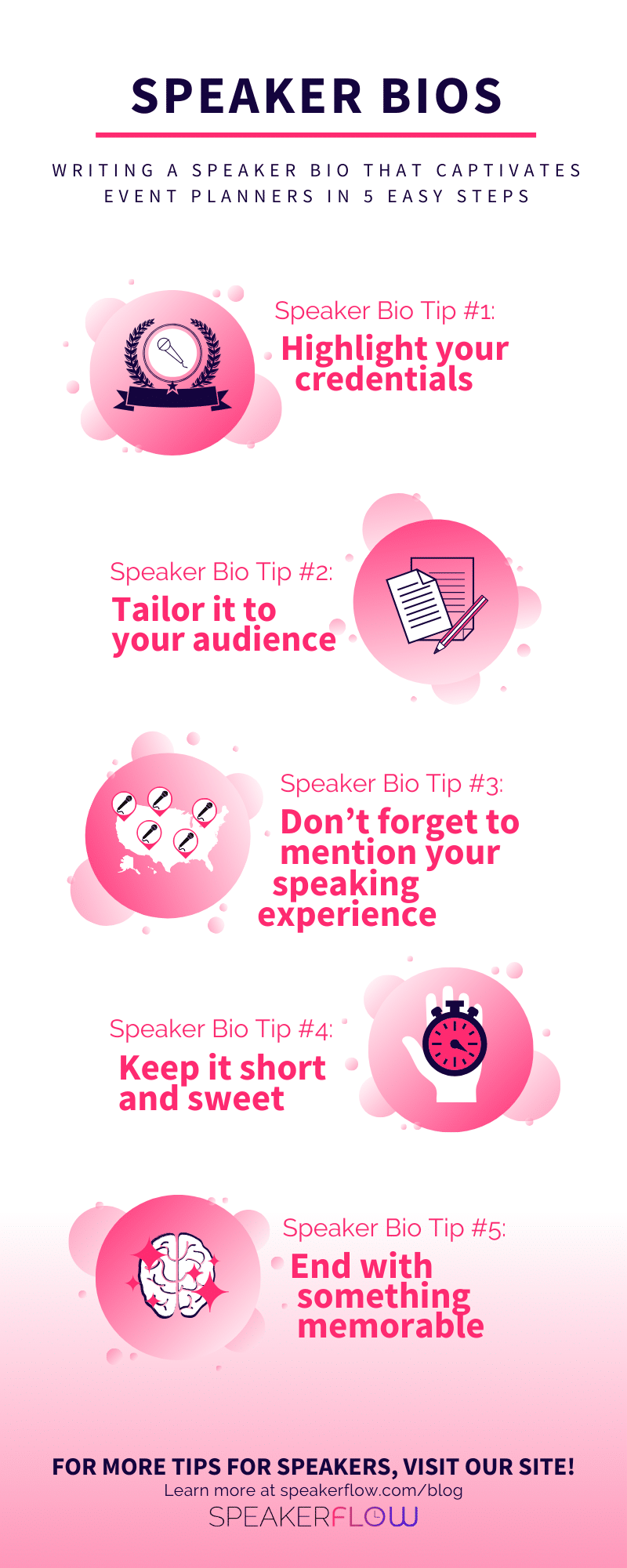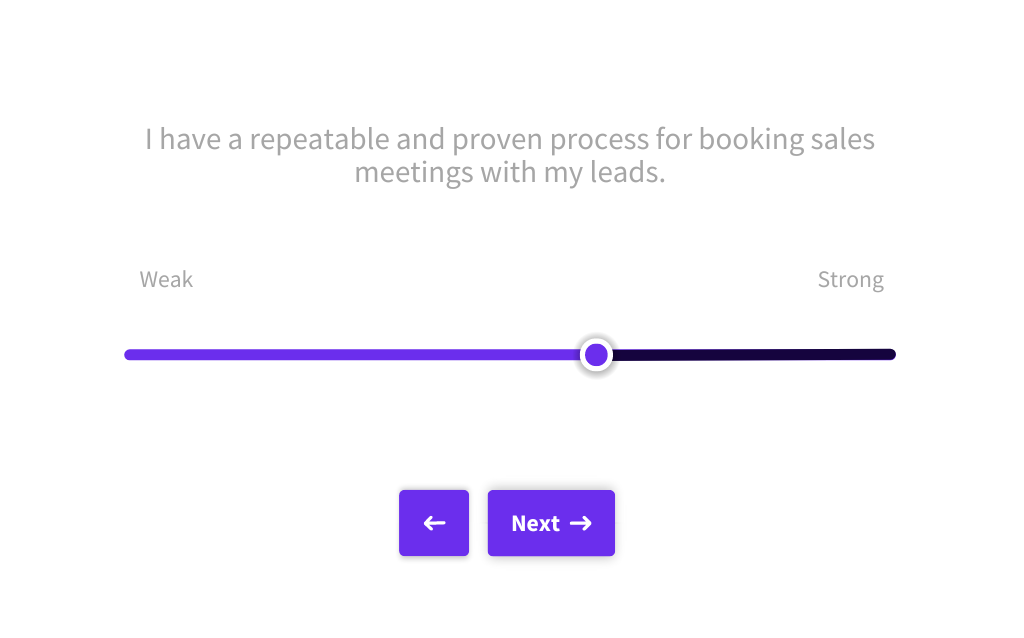If you’re an experienced speaker, you already know the role your speaker bio can play in the booking process. On the other hand, if you’re new to the speaking industry, this is the blog for you. An effective biography, regardless of the setting, needs to show your skill, your uniqueness, and your value. In short, your speaker bio is yet another digital resume of sorts for anyone you meet in your speaking career. This includes the decision-maker who booked you as well as potential clients at the gig. By writing a solid bio initially, you increase the likelihood of both these options, when it comes to booking gigs. That way, you can, hopefully, turn that single event into a handful of clients for the future.
Ultimately, there is plenty of advice out there, from salespeople and speakers, for what a good speaker bio looks like. Some of it, such as “name your value proposition” are fairly obvious. After all, your goal is to clearly demonstrate to anyone reading it that you are an authority. That said, there are several less discernible tips and tricks that can take your speaker bio to the next level. As you might have already guessed, that’s what we’re covering here. 👍 We’ll also cover a few of our favorite speaker bios and why they are stellar examples for you to reference.
1. Highlight your credentials.
The first and, in many industries, the most important piece to a good speaker bio is credentials. These include academic honors, certifications, or awards. Although this requirement varies depending on the speaker and the decision-maker, the more credentials you can work into your speakers bio, the better. After all, it’s rare that event planners turn down speakers for being overqualified (especially if their speaking fee is within budget). For speakers in lower or higher-level education, this piece of the puzzle can be especially important. This is largely because, for academic speaking events, many educators like to see a speaker that values education as much as they do and so has achieved a higher level of education themself.

However, there are several industries in which credentials aren’t necessarily required for guest speakers. These include corporate settings, such as marketing or sales, or “blue collar” settings, like construction or law enforcement. In these cases, industry experience can mean more to a decision-maker than a degree, simply because it allows them to assume you’ll easily relate to the audience. Additionally, for many in these industries, they may not have academic awards themselves, making them less likely to consider that a requirement, when it comes to choosing a speaker.
In the end, the desired accolades you’ll need can vary depending on the client and the industry. Your safest bet, when crafting your speaker bio, is to include the credentials you have and simply continue building them over time. Plus, in many cases, a solid set of testimonials or a decent number of past speaking events works just as well. As you book more and more events, focus on keeping clients happy and the easier the speaking gigs will come, meaning more awards, more referrals, and more credentials for your speaker bio.
2. Tailor it to your audience.
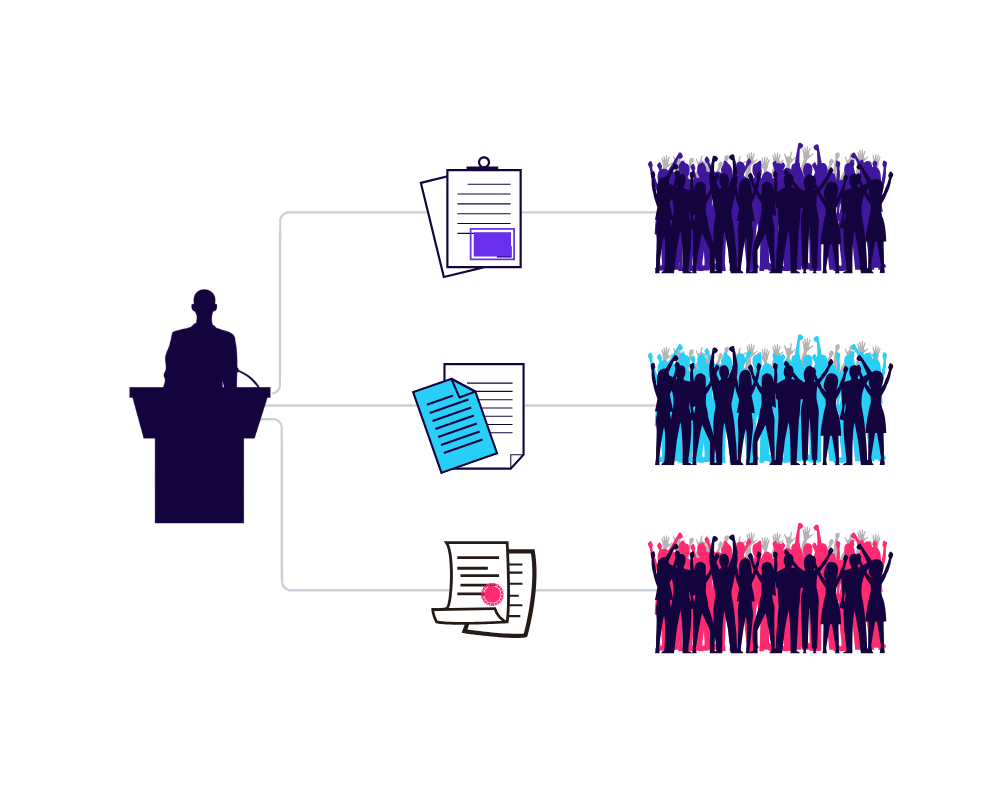
The second component of a satisfactory speaker bio is a less apparent one: customization. At first glance, it’s easy to think that the same speakers bio can be used time and time again. However, by tailoring your bio to each industry, you not only demonstrate the level of care you take in each event. You also increase the change of audience members reading your bio and, after seeing your presentation, saying, “Hey, we should hire them, too!” Plus, as you adjust your speaker bio over time, you can easily see which bios led to referrals. This allows you to troubleshoot and make adjustments using actual data. As a marketer, I’m a huge fan of driving with data. 🤷
In addition to industry-specific speaker bios, we’ve also seen speakers succeed with an even more detailed approach. This approach involves custom a custom speaker bio for each event. Although this sounds tedious, hear me out! Crafting a bio specific to the event allows you to show your skills and appeal to audience members, as always. But, because it’s event-specific, it also allows you to get to know the audience before you even start. For example, including a joke about the company hosting the event, mentioning the CEO or president running the gig – any way you can show the audience you did your homework is sure to win you fans. That way, even before you get on stage, they know that you already care enough about them to learn who they are and what they need.
3. Don’t forget to mention your speaking experience.
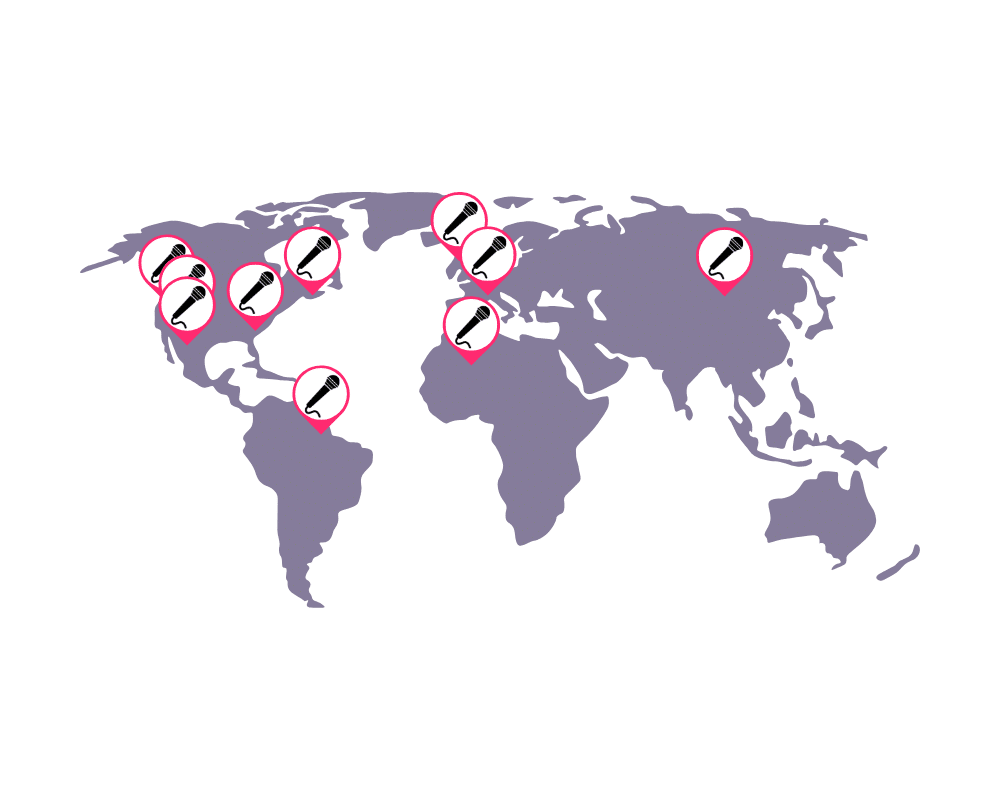
Third on the list is a biggie: speaking experience. Just as with academic experience or awards, mentioning your speaking experience is another key piece of a good speaker bio. Especially as you are working to build up your credentials, showing your skills on stage is a great way to ease event planners’ concerns. This means including a number of events (or a range, such as “over 100 events within the last year”) or specific types of events.
For example, let’s say you are looking into an event for the College of Design at the University of Minnesota. Although you don’t have a design-related degree, you have extensive experience in business. You’ve also spoken, in the past, for the Fashion Institute of Design & Merchandising and the Columbus College of Art & Design. Including these past events in your bio for the U of MN audience is an easy way to show them that although you may not share the same degree, you understand their experience. You also gain their trust before you even step on stage, to some degree, making them more likely to pay attention. As a result, they’re more likely to like you respect you right off the bat, more likely to remember you, and more likely to recommend you to other students and faculty. Win, win, win. 🙌
4. Keep it short and sweet.
Number four of the five tips for a good speaker bio relates to length. Mainly, remember to keep things short and sweet. Obviously, it’s impossible to write a tiny bio and include your credentials, speaking experience, and a relatable note for the audience. That said, at SpeakerFlow, we generally recommend having a short version and a long version of your speaker bio, the former being no more than 100 words (basically, the length of this paragraph). In this way, you allow the event planner to choose which version is best suited to their needs while still controlling the content of your bio.
5. End with something memorable.

Above all, when writing a good speaker bio, make sure they remember you! While including credentials, experience, and custom details is important, the greatest selling point is your personality. Some of today’s most well-known speakers succeeded not because their speaker bio was jam-packed with credentials. Instead, they grew to fame largely because they were personable and unafraid to be authentic. I’ve said this before in many of our guides, but staying true to yourself and your brand, in your speeches and your speaker bio, is a sure way to captivate people, before and after the event is over.
If you’re not sure how to make your bio stick in audience members’ minds, no worries! Starting with something small, like a tagline or a joke, is a great way to ease into a less professional writing style. Additionally, depending on the decision-maker, you may also be able to achieve the same result simply with less formal language. Here at SpeakerFlow, for example, we’re all about candidness in our meetings. This includes jokes, sarcastic banter, and profanity (if the client is comfortable with it, of course), such as the phrase “get sh*t done”. Talk to the event planner, when you’re crafting your bio prior to an event, to verify that you’re using an appropriate level of formality and iterate as needed.
Our 6 Favorite Speaker Bios
All in all, just as every speaking business is a little different, every speaker bio is different. So, when you’re writing your speaker bio, don’t expect your personal touches, language choices, and preferred style to match that of another speaker. To thine own self be true, right?
That said, if you’re looking for some inspiration, below are six of our favorite speaker bios here on the SpeakerFlow team. Some of the speakers below are world-renowned while others are smaller scale. However, each of them is exemplary for at least one of the reasons above and great for reference.
Katrina Cravy

First up to bat is former investigative consumer reporter Katrina Cravy. As candid on her site as she is in person, Katrina’s speaker bio is a perfect example of showcasing skill while keeping things brief. It’s also clearly written with her true voice in mind. For example, her entire “About” section begins with the following: “Hi! I’m Katrina. A TV and radio personality, entrepreneur, and true American-dream believer dedicated to helping YOU create and communicate a story that sells!” In just two sentences, she’s conveyed that she’s friendly, explained her experience, and indicated how she can help. Ideally, your bio would tick each of these boxes in the same way. Bonus points if you can keep it this short. 👌
Les Brown
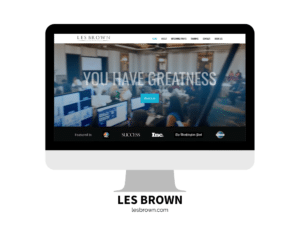
Next is international motivational speaker Les Brown. In contrast to Katrina, Les’s speaker bio is a great example of what a long-form bio should look like. At 644 words, it’s definitely one of the longest ones in this list. When crafting a bio of this length, it’s important to begin your bio with a clear explanation of your uniqueness. That way, even if the reader doesn’t cover every word, they’ll still see your value in the first sentence or two. In Les’s speaker bio, you can see this in the first paragraph, as he’s described as “a dynamic personality and highly-sought-after resource in business and professional circles for Fortune 500 CEOs, small business owners, non-profit and community leaders from all sectors of society looking to expand opportunity.” Likewise, in your own bio, regardless of the length, get your credentials and experience out in front.
Tony Robbins
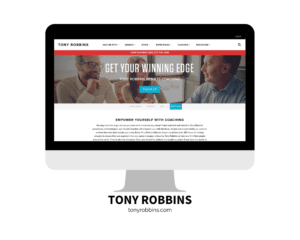
The third in our list of top speaker bios is a well-known motivational speaker: Tony Robbins. Known worldwide for his speaking as well as his philanthropy, Tony’s speaker bio is perfect if you’re looking for a way to showcase the information we covered while keeping it visually engaging. In his “About” page, you can see four distinct sections: a quick intro, “Best Selling Books & Sold Out Seminars,” “Enduring Transformation,” and “Worldwide Impact.” By dividing up his credentials, experience, and value into three parts, Tony breaks apart his bio, making it easier to read at a glance. It also allows him to include pictures of him in action, making the entire bio more memorable.
Simon Sinek
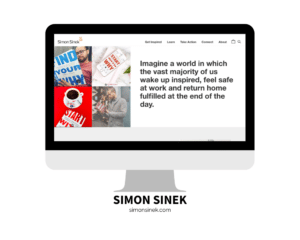
Another well-known speaker worth looking at is Simon Sinek. Speaker and author, Simon is known largely for his books, Start With Why and Leaders Eat Last as well as his TED talk in 2009. Unlike the other speakers in this list, Simon’s bio and his website as a whole are clear that he is part of a team. For many speakers, such as bureau owners or speaker managers, this approach may be helpful, as you’ll appear more reachable if it’s clear you have a team behind you (in case you’re on the road). In addition to a team-oriented approach, Simon’s bio us also an excellent example of highlighting credentials succinctly, if you need an additional reference.
Mel Robbins
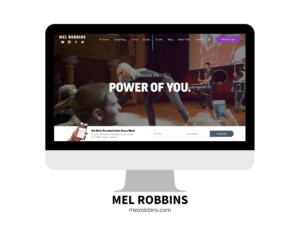
Fifth of the six speaker bios we love is that of Mel Robbins. If you haven’t seen Mel’s website or presentations, there’s a reason she’s so well known in the speaking industry. Besides her talent as a speaker, she also has a strong personality, and she sticks to it at her events. Her website’s “Meet Mel” section is no different. Although it’s lengthy and her credentials and value are dispersed on an extended page, the structure is designed to engage. Obviously, you won’t be able to build this level of interaction in a written speaker bio. However, you can definitely do this on your own website. Check out her bio page and you’ll see pretty quickly why the SpeakerFlow team and I think it’s so cool.
Erin O’Malley
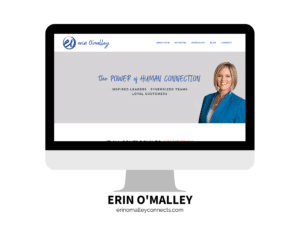
Finally, number six on our list of awesome speaker bios is Erin O’Malley. We had to include Erin in this list not just because she’s an amazing person. She also ticks every box on this list. In her speaker bio, she keeps it (relatively) short at 242 words, breaks up her credentials and value in separate paragraphs, and kicks off the entire thing with an explanation of why she’s exceptional. To the right of each paragraph, Erin also includes images of herself, both in professional and casual settings. In this way, you can not only see her competence but also her candidness. What’s not to love about a speaker that kills it on stage and makes friends with everyone in the audience?
In the end, your speaker bio will fluctuate as you gain experience. Remember, your bio is intended to appeal to event planners and to the members of your audience. Because of this, keeping it customized, complimentary, and concise is key. Additionally, never stop iterating. The more you can test different styles or phrases, the easier you’ll see which speaker bio works best.
If you already have a speakers bio, this guide is an easy tool to double-check that you’re maximizing its use. If you don’t have a bio, hopefully, this gives you an easy guide to follow. That way, you can start catching event planners’ eyes sooner rather than later. 👍
